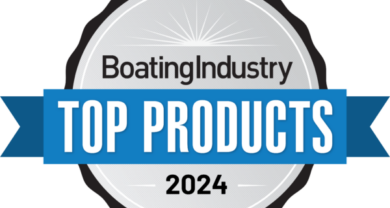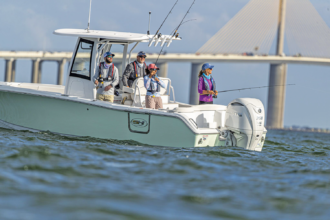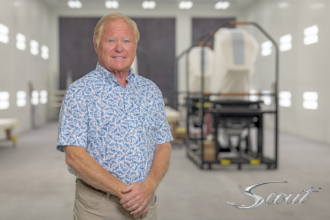Marketing Master
MasterCraft has a loud voice.
That’s according to John Dorton, CEO of the ski and wakeboard boat builder and chairman of the Grow Boating Marketing Task Force.
It can be heard through coverage of the professional sporting events it has created and those it sponsors, the ski schools in which it participates, the movie placement it has been chosen for, the race car drivers it sponsors, its partnerships with companies like Cadillac and Volkswagen, and its Web, magazine and boat show marketing.
The MasterCraft executive has turned his company into the largest boat builder within one of the industry’s healthiest segments: ski/wakeboard boats. The company has been expanding on an employee, dollar and unit basis over the past 10 years while builders in other sectors have laid-off workers and cut production rates based on double-digit declines. In fact, MasterCraft’s revenues have leaped from $48 million in 1997 to more than $200 million in the 2007 fiscal year, and its unit volume has climbed from 2,200 boats in 1996 to 3,639 in 2007. While marketing is only one of many factors contributing to its success, Dorton says it’s a critical component.
“We’ve not had a decline in revenues or earnings since I’ve been here,” he comments. “Typically, we’ve seen double-digit percentage growth. Our aggressive stance on marketing is why we haven’t seen a dip in business.”
The industry would like to boast similar growth rates. And with Dorton leading its marketing efforts, perhaps it too can develop the “loud voice” necessary to be heard over its competitors in the leisure sector.
Leading the way
The MasterCraft executive certainly has gained the respect of his peers.
Not only did those industry leaders who helped found the Grow Boating Initiative nominate Dorton as chairman of its Marketing Task Force, his leadership of it has since been touted as a vital part of the Discover Boating campaign’s success.
“He’s a strong leader,” says Carl Blackwell, NMMA vice president of marketing. “As chairman, he allows for there to be ample discussion, but at the end of the day, he sees through the arguments and brings consensus to people that are pretty opinionated. Without John, I think we would probably still be discussing the first creative execution.”
Blackwell points out that Dorton’s most significant contribution is his ability to put aside his passion for his boating niche – and coach the others to do the same.
“It’s not about promoting a series of boating niches,” Blackwell explains. “It’s about promoting the boating lifestyle. He doesn’t let us forget that.”
Both Dorton and Blackwell agree that on an individual company basis, the industry tends to advertise to the same people again and again – and often in similar ways.
“Part of the challenge the industry faces is that our individual marketing budgets don’t allow us to do a lot of mainstream advertising,” Blackwell says. “That’s the beauty of Discover Boating. We can do something together that we can’t do
alone.”
MasterCraft is actually one of the few marine companies that consistently seeks to employ marketing agencies outside the boating industry. In fact, it hires from the same pool of agencies that the Discover Boating campaign does.
“John has almost been a mentor to me,” Blackwell concludes, “and I think the other members of the task force look up to him. He’s a key cog in the success we’ve had to date.”
Not only has MasterCraft garnered praise for its marketing efforts within the industry, it can hold its own outside the industry as well. Earlier this year, the company took home two of the American Advertising Federation’s ADDY Awards, both in the Interactive Media division – a silver in the Web Site, Consumer Flash-Based category and a silver in the Online Micro-Mini Site category.
Mastering innovation
A big part of the boat builder’s success is due to marketing innovation across the board, from its award-winning Web site – which draws about 75,000 visitors per month – and its event marketing – the company created the Pro Tour and sponsors the X Games – to the retailing environment it helps to provide.
A recent example of the company’s eye for innovation is its investment in the Texas Ski Ranch in New Braunfels, Texas, a 70-acre action sports complex where families can participate in wakeboarding, waterskiing, rock climbing, skateboarding and riding motocross; shop for related sporting goods – including boats – and eat at the center’s restaurant.
A person can use TSR’s cableway and rent wakeboarding or waterskiing equipment for an entire day for $61. Annual cableway memberships are only $750, and weekly and monthly membership packages are also available. TSR offers professional ski and wakeboard instruction along the cableway or behind a MasterCraft boat, as well as through its summer camp for kids age 6 to 16.
When, after developing a passion for watersports activities, a person wants to buy a MasterCraft, the center has a full-service dealership on site with its own private demo lake.
“TSR is a fairly extreme example of experiential retailing,” Dorton explains. “TSR and others like it allow people a chance to demo the boats and the boards, and participate in the sports as a guest, if you will, to see if that’s a sport they want to pursue.”
He points out that watersports can be difficult to access for most consumers, and few are willing to buy the necessary equipment, boat and tow vehicle to simply try them out. The center also serves as a form of cross-marketing. Those interested in rock climbing, skateboarding and motocross are exposed to waterskiing and wakeboarding, sports they might not otherwise encounter.
“We are farming the next generation of boating,” explains Dorton, who says others are embracing similar concepts. He expects such venues to open up nationwide at the rate of a couple per year.
Taking root
Dorton’s marine marketing expertise didn’t come out of nowhere.
For one, he developed a passion for boating early on. As a kid, he says, “I was always happiest on the water.” In fact, his mom would pick him up from school, boat in tow, and take him straight to the lake.
“I had a boat before I had a car,” he admits.
As a college student at the University of Tennessee, he joined the school’s ski team, and after graduating with a degree in marketing and advertising, his first priority was to get a job at MasterCraft, a goal that proved harder to reach than he’d hoped.
It was many years later, after Dorton had worked for several ad agencies, directed the marketing efforts and new business development for a fitness equipment chain and ran his own catalog company, that he was able to secure a position at MasterCraft as marketing director. Two years after joining the company, however, he was promoted to CEO.
Dorton says his marketing background has been helpful in his leadership of MasterCraft.
“It helped me understand consumer sciences related to buying our boats,” he explains. “It helped me identify what’s important to [boat buyers]. And it helped me identify new opportunities.”
The executive points out that all leaders have expertise in one area and must develop strengths in others. For him, engineering, operations, systems and finance were areas in which he had a lot of learning to do.
It’s difficult to imagine where MasterCraft would be today without Dorton’s marketing finesse. His ability to get inside consumers’ heads has led the company to successfully enter four new markets over the past 10 years, growing from 5 models to 24 while remaining loyal to the MasterCraft brand.
Dorton believes consumers expect the same level of innovation from MasterCraft’s marketing as from its products. Both need to be “breakthrough,” he says.
“Our mission is to lead the industry in marketing,” he explains.
Mission accomplished.
From niche to niche
A major contributor to MasterCraft’s growth has been its ability to identify and target new usage niches.
The company was launched in 1968 as a tournament ski boat builder, and that didn’t change much until 1996. When Dorton became president, it produced 5 boat models – the foundation for what is now its ProStar line – for a total of about 2,200 boats per year.
“I felt that segment was on the decline,” he comments. “My marketing intuition gave me an idea for what categories we could grow the business into, and while we’ve been successful at different levels, we haven’t failed in any of them.”
Soon after Dorton assumed his new leadership role, MasterCraft launched the X family of wakeboard boats. Next, the company moved into family recreation with its Maristar product family. Then, after observing the U.S. population’s coastal migration trend, MasterCraft created its saltwater line, followed more recently by its CSX fish and ski boat, launched during the 2007 model year. Today, the company offers 24 models and produces about 3,700 boats per year.
While many of these new MasterCraft customers were boaters, Dorton believes product innovation also can play a major role in attracting new people to boating.
“Marketing has to overcome perceptions,” he says. “But product development needs to overcome the realities.”
While the ski and wakeboard segment has among the highest product satisfaction levels in the industry, according to J.D. Power & Associates, Dorton points out that other niches are not that fortunate. “People may not have a good experience with [a boat]. It’s not a matter of changing the marketing message at that point. It’s about changing the boat.”
MasterCraft was, in fact, focused on attracting new people to boating when it designed the new CSX product family. The boats, which feature optional sporting goods equipment racks and keel guards to allow them to be pulled up on the beach, are targeted at “people who are into mountain biking, hiking, camping, fishing and kayaking,” Dorton says.
“This may be the first MasterCraft on which boaters will never wear their bathing suit,” he comments. “This could be the boat for nonboaters.”
As the industry continues to reach out to new consumers, one key to its success may come in the form of new product development.
“I’d like to see boat builders invest in new product,” Dorton says, “and improve existing products to allow us to bring people into the industry.”
A different kind of ski school
Not everyone can benefit from the popularity of skiing and wakeboarding. But there are lessons marine companies in other segments can take from MasterCraft’s strategies.
1.“Tie use of your products to participation in an activity above and beyond boating,” Dorton suggests. That doesn’t have to be skiing, wakeboarding or even fishing – though all three are excellent examples. It can be dine-a-rounds, poker runs, sailboat races, group cruises, trips to local destinations (think wineries, museums, on-water festivals or sporting events) – anything that will get boaters excited about using their boats.
2. Through its research, MasterCraft has identified a state of time poverty for many families in which kids overparticipate in sports like soccer, cheerleading and football. At its most extreme, kids are training year-round with families transporting them across the state, and sometimes the country, to participate in competitions. One way to connect with families is to market the boating lifestyle as a healthy alternative. “We have to create a balance and boating fits in nicely,” Dorton explains.
3. Many marine marketers use boating publications to try to sell consumers on the boating lifestyle. Dorton, however, believes that those who read boating publications already understand the value of the lifestyle and are “trying to decide which boat to buy.” MasterCraft advertises in boating publications “to sell fiberglass” and believes others would be well suited to do the same. Lifestyle messages should be reserved for nonendemic marketing pursuits, he suggests.
4. Boating businesses are often guilty of marketing to their competitors rather than consumers, says Dorton. Everyone in the industry reads the same marine publications and many times competitors’ marketing messages are taken personally with opposing messages launched in response. Dorton says boating companies also often copy each other’s marketing messages. “It’s like BMW saying, ‘We’re the Ultimate Driving Machine,’ and Ford saying, ‘We’re the Machine Driving Ultimately.’” Both of these practices confuse consumers rather than winning them over. Boating businesses would be better off focusing on their own position in the market, using it to differentiate themselves from competitors, he believes.
5. MasterCraft has been a steady investor in marketing throughout its history, despite market fluctuations. Dorton says a downturn is “the time you invest heavily in marketing, but it’s got to be smart marketing.” He suggests marketers think like a consumer, matching the company’s advertising messages with the personality of its products.




